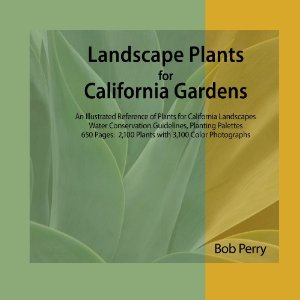Landscape Plants for California Gardens
Author and Landscaper Bob Perry’s New Book
Avid readers who garden (or gardeners who read) in California will probably have already encountered Bob Perry’s work. His Landscape Plants for Western Regions has become a must-have for serious landscapers. For his previous fans, the appearance of his latest work, Landscape Plants for California Gardens, will be very welcome. For those who have not yet encountered Perry’s writing (he also published Trees and Shrubs for Dry California Landscapes), this volume should become a great source of information and perhaps an indispensable tool to make good landscaping choices.

Bob Perry is Professor Emeritus of Landscape Architecture at California State Polytechnic University, Pomona (Cal Poly Pomona), where he has been teaching since 1972 with a focus on water conservation and appropriate plant selection. But another stellar feature of his latest work highlights an additional talent: photography. There are 637 pages of text, and all of them have at least one colorful photograph. This is a beautiful book. It is also a very large and heavy book. High-quality paper and binding make it hefty, requiring a nice flat surface to rest it on (not one to curl up with in bed) while referencing.
The main feature is, of course, the encyclopedic “plant compendium” that references an “A-Z Listing of 2,100 Plants.” Each entry consists of an introductory paragraph about the genus (if applicable) that gives general information, including number of species, habit, and landscape requirements for the group. Then, the individual species and cultivars are briefly described with all pertinent information. Height, spread, foliage, flower characters, and comments on the best features of the plant are accompanied by three other sections of extremely condensed sources for quick reference on “Plant Climate Zones and Water Estimates,” “Plant Lists”—specific recommendations for particular characteristics of site or plant type—and “Plant Palettes,” which is subdivided again for different water requirements.
These last three sections are actually first in the book, and they may seem rather daunting at initial glance. There are pages of little charts and graphs (happily interspersed with beautiful photographs) accompanied by concise text. Taking them one at a time and applying them to a particular place can help alleviate the information overload. It is in these sections that the book seems more like a textbook, but it contains a huge amount of useful information all condensed in one central place. This is stuff that has been published before but would require some sleuthing to locate again. For example, “Reference Evapotranspiration” is a complex statistical model that has been developed to calculate just how much water plants and landscapes lose to the atmosphere. The factors involved include water loss from evaporation from the soil surface, as well as plant surfaces and transpiration—the loss of water from plants as they perform photosynthesis. Affecting these is the amount of solar radiation, air temperature, relative humidity, and wind speed of any given site. Not something most gardeners can capably estimate. The other really important feature of this section is to provide charts listing every plant that is described in the book with columns rating its “Plant Factor” (a measure of how much supplemental water it needs relative to the local conditions), its “Irrigation Group,” and the specific plant climate zone (with accompanying maps) in which it will thrive.
In addition, “Section Two—Plant Lists” is simply a compilation of a lifetime of landscape experience with specific plants sorted into logical landscape uses. Lists of “California Native Plants,” “Mediterranean Garden Plants,” and more accompany lists segregated by plant type—“Flowering Shrubs,” for example, and “Plant Functions and Aesthetics.” Need a tree for your courtyard or patio, a plant that has fragrant flowers or leaves, or one with colorful fall foliage? Plants with these attributes are listed for your consideration.
“Section Three—Plant Palettes” really gets to the nitty gritty. There are two subheadings dividing the contents into plants that require regular water and reduced summer water (heed the definitions). Other subdivisions within these have headings titled with the name of a particular plant. This naming convention is not necessarily intuitive, but the “palettes” themselves have cohesion. Each has a “design purpose, climate zone suitability, aesthetic character, and moisture need.” These combinations are useful in organizing plants within a similar irrigation scheme (hydrozone, in the parlance of landscape design), as well as combining them according to complementary form and color schemes. This may be more useful for professionals, but novice gardeners will find much to inspire them, as well.
4•1•1
Bob Perry’s Landscape Plants for California Gardens (2010) is available through the publisher at landdesignpublishing.com.



